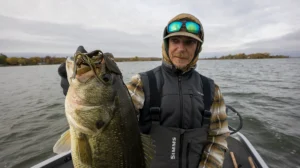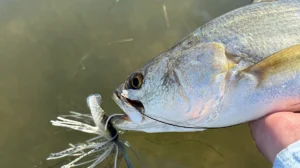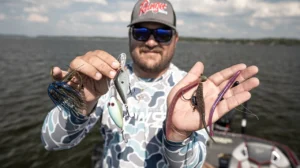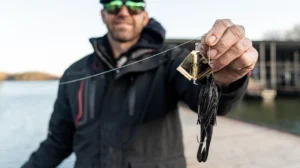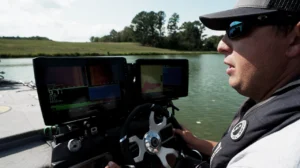Long before Keith Combs won three Toyota Texas Bass Classic titles and became known as one of the world’s foremost crankers, he leaned heavily on the Carolina rig. “It was an all-depth, all-year type bait for me,” Combs recalled.
The unspoken part of that admission, though, is that he never retired the ball and chain. Sure, he’s supplemented it with other techniques, including dropshot, football and swing-head jigs. These additional techniques may have changed when and where he uses the Carolina rig, but it’s still an elemental part of his arsenal.
“Nowadays one of the times I use it most is when there’s a tough fall bite,” Combs said. “That could be on shallow bars, or it could be on Texas lakes, when they’re shallow on sandy points. You might see them blowing up on gizzard shad, but they’re so shallow and so dialed into the bait, that you don’t even try to imitate the bait. Instead, the Carolina rig gives you several key advantages.
SHALLOW DRAGGIN’
Historically, the Carolina rig has been thought of primarily as an offshore tool, able to get deep quickly and stay there at any speed. Where Combs often bucks that trend, even with the same 1-ounce weight, is that he may employ it in ankle- or knee- deep water.
“The first advantage is that you can make a really long cast,” Combs explained. “Even off the point, it might be only 4 or 5 feet. Those fish are often spooky, which makes a long cast important. Second, those fish are dialed into any kind of sound. They’ll come to it, but they may not eat it. By this time in the year, they’ve seen squarebills, they’ve seen Sexy Dawgs. They’re just worn out.”
It’s not just down south and it’s not just largemouths, either. In a tournament on the Upper Mississippi out of LaCrosse, Wisconsin, he found smallmouths occasionally blowing up on a big shallow sandbar. It was too shallow for any sort of CrankBait, and they wouldn’t touch his topwaters. The Carolina rig triggered the bites he needed.
“You can fish it a lot faster and the bait stays up off the bottom a bit,” he said. “That’s the zone they are often feeding in.” Because smallmouths are particularly curious and often attracted to noise, he felt that the more casts he made, the better. Each initial ker-plunk rang like a dinner bell.
SIMPLIFIED C-RIG BAITS AND TACKLE
When Combs began his Carolina rig journey, the standard lures to use were a lizard and a French fry-style stubby soft plastic. The former is still in his arsenal, but today it’s more likely to be complemented by a Strike King Game Hawg; an elongated, multi-appendage creature bait. There’s no formula to determine which one he chooses on a particular day.
“It’s a matter of trial and error, kind of like throwing a lipless crankbait and a ThunderCricket in the pre-spawn. They’re both going to work, but often one will be better than the other.” Green pumpkin and watermelon red are his go-to colors, but in darker water and especially on Texas lakes he’ll often mix in black and blue, as well as junebug. When it’s stifling-hot, he’ll rotate in a Strike King Caffeine Shad fluke-style lure, which has a particularly erratic action on a fast retrieve and will thereby trigger strikes.
He almost always uses a 1-ounce weight, and it’s almost always a Strike King tungsten model, but at times he’ll still revert to old school lead. “If you’re getting hung up in rocky cover, that’s an easy change, because lead doesn’t wedge into those cracks like tungsten.”
He throws the rig on a 7-foot, 6-inch medium-heavy moderate fast Lew’s Custom Lite baitcasting rod paired with a high-speed Lew’s BB1. “You want a relatively large spool, at least a 150 size,” he said. “As for the rod, it’s a balance. You need some power in the midsection, but if you get too heavy or stiff your casting distance will be affected. You need that length at the end of a long cast. When I feel the bite, I reel down and rear back. Those big fish in warm water will hit and move several feet to the side, so you’re going to have some bow in your line that you’ll need to pick up.”
DIFFERENCE MAKERS
While Carolina rigging is a technique that lends itself to novices and serious tournament competitors alike, there are certain things that can help you get more bites. First, though, it’s key to avoid a common pitfall.
“You need to concentrate,” Combs said. “They can grab that thing, eat the bait, and become deeply hooked before you even know it. I’m feeling for pressure. A bite is usually a dull, mushy feel. You need to check it out, but you don’t want that fish to feel you. I move my rod tip down at the same speed I’m reeling, and then when I’m pretty sure he’s there I make a long, sweeping, sideways set. The good thing is that once they’re hooked, there’s a very high catch ratio.”
Next, following up on the noise thread from above, he doesn’t use any sort of ticker or clacker between his weight and his swivel, but he does add a bead in that spot – not just for noise but also for line protection. “This is very important, and I know they’re hard to find, but you want a bead with a big enough hole to cover the entire knot. You don’t want it sitting on top of the knot in any way.”
He likes the fact that he can fish the rig fast, but noted that when he gets into a rough patch or something slightly different from the surroundings, he’ll slow it down and keep it there until he’s sure there’s not a biting bass around. The action of the lure is also impacted by leader length, which is an oft-discussed and heavily-disputed feature of the cannonball. Combs usually starts at around 4 feet, simply because anything longer is hard to manage.
One problem with the longer leader, especially on Texas lakes like Sam Rayburn, Toledo Bend and particularly Falcon, is that “fish will often bite the sinker.” You can tell that’s happened if you swing and miss, only to come back with a sinker covered with teeth marks. “When that happens, I shorten the leader down to about a foot. That almost always helps me catch more fish.”
Here’s more Carolina rig tips from Wired2fish’s Terry Brown.
TEST OF TIME
Despite those wrinkles, it remains effectively the same tool that it was 40 years ago, just with updated components. “It’s not as sexy as a lot of baits that are popular right now, but in the pre-spawn and then again about now in September and October it accounts for a lot of big fish, and a lot of tournament wins,” said Combs.










